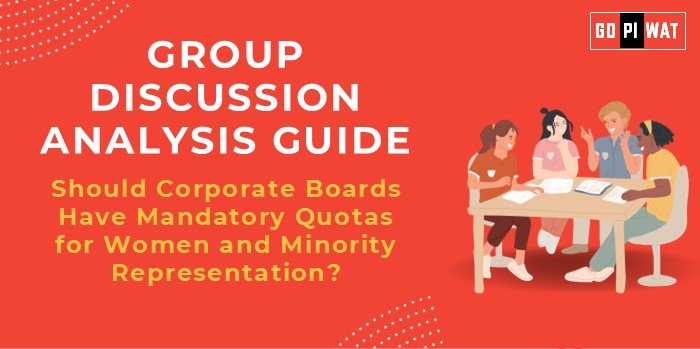📋 Group Discussion Analysis Guide: Should Corporate Boards Have Mandatory Quotas for Women and Minority Representation?
🌐 Introduction to the Topic
Opening Context: “The issue of diversity and inclusion in corporate leadership has become a global focal point, especially as businesses strive for equality, innovation, and growth. Implementing mandatory quotas for women and minorities on corporate boards has sparked extensive debate worldwide, highlighting its relevance in today’s corporate and socio-economic landscape.”
Topic Background: Gender and minority representation in boardrooms has been historically low. Countries like Norway, Germany, and India have implemented mandatory quotas, while others prefer voluntary initiatives. The effectiveness of such policies remains under scrutiny, with strong arguments for both inclusion and meritocracy.
📊 Quick Facts and Key Statistics
• 🇮🇳 Indian Context: SEBI mandates at least one woman on listed company boards; women hold 17.1% of board positions in NIFTY 500 companies.
• 🇳🇴 Norway’s Success: Board quotas (40% for women) increased compliance to 41% in a decade.
• 💰 Economic Benefits: Companies with diverse boards report 33% higher profitability (McKinsey, 2023).
• ⚖️ Challenges Persist: Barriers to inclusion remain significant for minorities despite mandates.
🤝 Stakeholders and Their Roles
- 🏛️ Governments and Regulators: Set and enforce diversity policies.
- 💼 Corporate Leaders and Boards: Implement diversity measures and foster inclusive environments.
- 🌟 Women and Minority Groups: Represent underrepresented voices and contribute to equitable decision-making.
- 📈 Investors and Shareholders: Demand diverse boards for better governance and profitability.
- 🌍 Global Think Tanks and NGOs: Advocate for improved diversity metrics through research and guidelines.
🏆 Achievements and Challenges
✨ Achievements:
- 📈 Economic Growth: Diverse boards improve financial performance, as shown in McKinsey studies.
- 💬 Social Impact: Promotes equal representation and role modeling for future generations.
- 🌍 Global Precedents: Countries like Norway, Germany, and France have significantly increased board diversity.
- 🇮🇳 Indian Progress: SEBI’s mandates improved compliance among listed companies.
⚠️ Challenges:
- 🪙 Tokenism: Quotas may lead to symbolic representation without real decision-making power.
- 🎯 Meritocracy Concerns: Quotas might undermine merit-based appointments.
- 🌐 Cultural Resistance: Deep-rooted biases and traditional corporate cultures pose barriers.
🌎 Global Comparisons:
- 🇳🇴 Norway: Leader in diversity quotas, achieving long-term cultural and economic benefits.
- 🇺🇸 USA: Relies on voluntary initiatives with mixed success.
- 🇮🇳 India: Improving compliance but still facing challenges in meaningful representation.
📝 Case Study: Norway’s boardroom quota policy increased female representation from 9% (2003) to over 40% (2014), proving quotas’ effectiveness when backed by regulation.
🗣️ Structured Arguments for Discussion
Supporting Stance: “Mandatory quotas ensure equal opportunities and foster innovation, driving long-term business success.”
Opposing Stance: “Quotas undermine merit-based selection and can result in tokenism rather than meaningful inclusion.”
Balanced Perspective: “While quotas accelerate representation, they must be complemented with inclusive leadership policies and merit-driven frameworks.”
💡 Effective Discussion Approaches
- 📜 Opening Approaches:
- Statistical Impact: “Despite women constituting nearly half the workforce, only 20% of global board seats are held by women.”
- Case Study Reference: “Norway’s 40% quota led to measurable improvements in diversity and business outcomes.”
- 🛠️ Counter-Argument Handling:
- Against Tokenism: “Diversity quotas create visibility, which often leads to improved decision-making and inclusion.”
- Meritocracy Focus: “Quotas ensure talent pools are diversified without compromising skills.”
📈 Strategic Analysis of Strengths and Weaknesses
- 🏅 Strengths: Encourages diversity, enhances governance, drives profitability.
- ⚠️ Weaknesses: Potential tokenism, risk of undermining meritocracy.
- 💡 Opportunities: Promoting leadership pipelines, combining quotas with mentorship programs.
- ⚡ Threats: Cultural resistance, slow adoption, enforcement challenges.
🎓 Connecting with B-School Applications
- 📚 Real-World Applications: Explore diversity management in leadership; analyze outcomes in diverse vs. non-diverse boards.
- 💬 Sample Interview Questions:
- “Should quotas for women and minorities be implemented globally? Justify your view.”
- “What are the risks and benefits of mandatory board diversity quotas?”
- 🔑 Insights for B-School Students: Understanding diversity’s role in governance and building inclusive leadership frameworks during projects.


